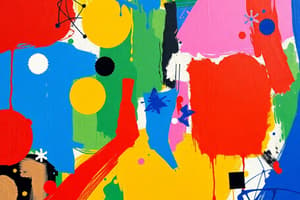Podcast
Questions and Answers
Which layout emphasizes font size and is usually used for headlines?
Which layout emphasizes font size and is usually used for headlines?
- Silhouette Layout
- Rebus Layout
- Big-Type Layout (correct)
- Alphabet Layout
A rough layout is a quick visual idea and does not provide an accurate appearance of the proposed design.
A rough layout is a quick visual idea and does not provide an accurate appearance of the proposed design.
False (B)
What is the purpose of a comprehensive layout in the design process?
What is the purpose of a comprehensive layout in the design process?
To represent the closest visual form to the actual printed piece and allow the client to check final color choices and design.
The __________ layout emphasizes the arrangement of letters or numbers in a way that forms a word or conveys an idea.
The __________ layout emphasizes the arrangement of letters or numbers in a way that forms a word or conveys an idea.
Match each layout type with its description:
Match each layout type with its description:
Who designed the current IBM logo and the third UPS logo?
Who designed the current IBM logo and the third UPS logo?
The original Kodak logo included 'EKC' representing 'Eastman Kodak Company'.
The original Kodak logo included 'EKC' representing 'Eastman Kodak Company'.
What colors did Pepsi adopt in 1941 to honor the United States?
What colors did Pepsi adopt in 1941 to honor the United States?
The first camera made by Canon was named __________.
The first camera made by Canon was named __________.
What notable design did Raymond Loewy create?
What notable design did Raymond Loewy create?
Match the logo to its corresponding year of evolution:
Match the logo to its corresponding year of evolution:
Haloid changed its name to Xerox after the success of Chester Carlson's invention.
Haloid changed its name to Xerox after the success of Chester Carlson's invention.
What was the original picture used in Canon's first logo?
What was the original picture used in Canon's first logo?
Which technique is NOT used to create emphasis in a layout?
Which technique is NOT used to create emphasis in a layout?
Unity in layout refers to the separation of elements in an advertisement.
Unity in layout refers to the separation of elements in an advertisement.
What is the main purpose of movement in a layout?
What is the main purpose of movement in a layout?
A layout that focuses heavily on text is known as a ______ layout.
A layout that focuses heavily on text is known as a ______ layout.
Match the layout format with its description:
Match the layout format with its description:
Which of the following principles of good layout is focused on maintaining visual balance?
Which of the following principles of good layout is focused on maintaining visual balance?
Clarity and simplicity in layout should prioritize complexity to attract interest.
Clarity and simplicity in layout should prioritize complexity to attract interest.
Name one technique used to create emphasis in a layout.
Name one technique used to create emphasis in a layout.
Flashcards
Multi-Panel Layout
Multi-Panel Layout
A layout divided into multiple sections, all having the same shape (e.g., square, cube).
Silhouette Layout
Silhouette Layout
A layout using illustrations or photos highlighting only the shadow or outline of objects.
Big-Type Layout
Big-Type Layout
A layout using a large font size, typically for highlighting headlines.
Rebus Layout
Rebus Layout
Signup and view all the flashcards
Alphabet Layout
Alphabet Layout
Signup and view all the flashcards
IBM logo designer
IBM logo designer
Signup and view all the flashcards
Xerox name change
Xerox name change
Signup and view all the flashcards
Kodak's early name
Kodak's early name
Signup and view all the flashcards
Shell logo designer
Shell logo designer
Signup and view all the flashcards
Pepsi's war effort colors
Pepsi's war effort colors
Signup and view all the flashcards
Yahoo logo sound
Yahoo logo sound
Signup and view all the flashcards
Canon camera name
Canon camera name
Signup and view all the flashcards
Kodak's original name
Kodak's original name
Signup and view all the flashcards
Layout Balance
Layout Balance
Signup and view all the flashcards
Layout Movement
Layout Movement
Signup and view all the flashcards
Layout Unity
Layout Unity
Signup and view all the flashcards
Layout Clarity/Simplicity
Layout Clarity/Simplicity
Signup and view all the flashcards
Layout Emphasis
Layout Emphasis
Signup and view all the flashcards
Mondrian Layout
Mondrian Layout
Signup and view all the flashcards
Picture-Window Layout
Picture-Window Layout
Signup and view all the flashcards
Copy-Heavy Layout
Copy-Heavy Layout
Signup and view all the flashcards
Study Notes
Art vs. Design
- Art is the expression or application of human creative skill and imagination, typically in a visual form. Works are appreciated for their beauty and emotional power.
- Design often considers aesthetic, functional, economic, and sociopolitical dimensions of both the object and process. Design is about creating, fashioning, executing, or constructing according to a plan.
Good Art
- Inspirational: Art has emotional context and sparks questions. Its meaning varies based on individual experiences and emotions.
- Interpretive: Art is judged subjectively, its interpretation varies.
- Taste-driven: Art is judged by personal opinion and taste.
- Talent-driven: Artistic ability is often innate, though it can be cultivated or refined.
- Unique Message: Art exists as self-expression, attempting to communicate a message, but it's not always a factual message, but rather a feeling.
Good Design
- Motivational: Good design motivates a person to do something or display a message directly.
Logo Design
- Purpose: A logo is a graphic symbol for instant public recognition. It's a flag, signature, or symbol.
- Meaning from Symbol: The logo derives its meaning from the quality of the thing it represents, and not the other way around.
- Less Important than Product: The logo itself is less important than what the logo represents
- Historical Progression:
- Early logos were simple marks or literal brands.
- 1800s-1900s: Logos became more complex, reflecting brand development.
- 1900s-1930s: Trademarking became more commonplace, leading to more advanced brand identities.
- 1930s-1980s: Designers like Paul Rand, Milton Glaser, and Alan Fletcher revolutionized the industry.
- Modern logos (1980s-present): Emphasize simplicity, flexibility, and memorability.
- Logo Design Process:
- Design brief: Client interview or questionnaire.
- Research: Industry analysis, competitor research, and relevant trends.
- Reference: Logo design research.
- Sketching and Conceptualizing.
- Reflection and revisions: Feedback, and further development.
- Presentation: Deliver the best logo.
- Principles of Effective Logo Design:
- Simple, memorable, & timeless.
- Logo Evolution Examples: Evolution of various notable logos throughout history provided, including Apple, Yahoo, IBM, Xerox, Kodak, Canon, Shell, Pepsi, Coca-Cola, Detective Comics, McDonald's, Lego, General Electric, Nike, Starbucks, KFC, and Nokia.
Studying That Suits You
Use AI to generate personalized quizzes and flashcards to suit your learning preferences.




